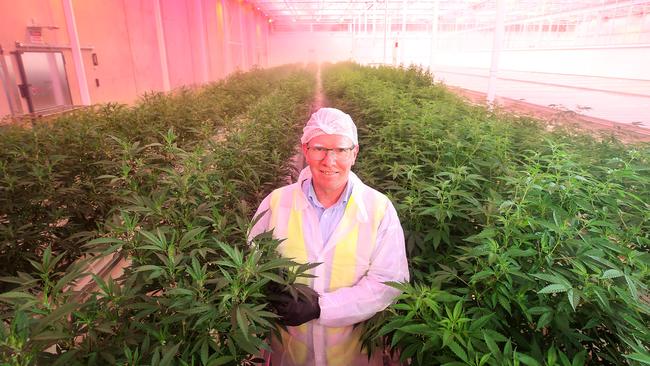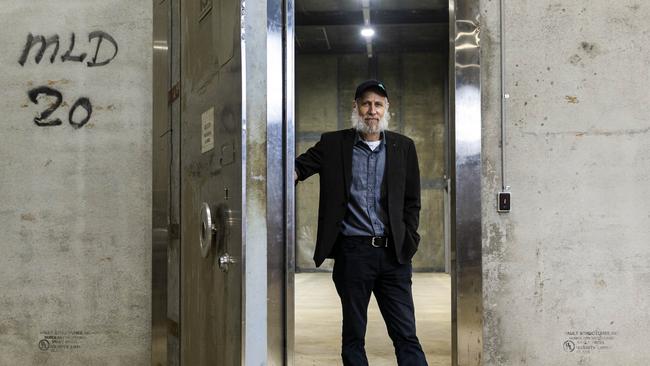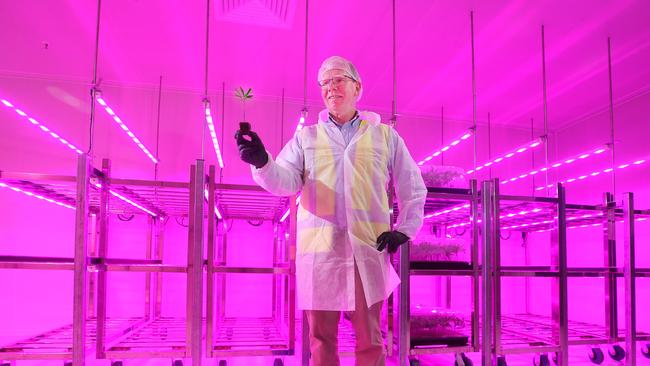Medicinal cannabis production in Australia is entering a new era
Medicinal cannabis companies are in a race to capture a slice of a $400 million market, and are creating hundreds of regional jobs in the process.
Surrounded by Mallee scrub on the outskirts of an isolated northwest Victorian town, a building marked only by a security checkpoint and a tall barbed wire fence is home to one of the most valuable crops in the country.
In July, the building made international headlines when the company running it inadvertently left the blinds open after the sun went down, sending a jet of bright pink light into the sky that prompted local theories of aliens and time portals and exposed the secret location of Australia’s largest medicinal cannabis production facility.
The company running the site, ASX-listed Cann Group, is in a race to capture what could be a $200 million prize — gaining approval for the first medicinal cannabis product for sale over the counter at Australian pharmacies.
The stakes are high. Since medicinal cannabis became legal in Australia in 2016, the industry has flooded with players keen for a slice of what is tipped to be $400 million in Australian sales in 2022, and a chance to export to a global market worth $80 billion by 2024.
As of May this year, 66 licences had been issued for the cultivation of medicinal cannabis in Australia, and 57 licences for manufacturing.
There have already been casualties. As the market becomes increasingly crowded, some companies and projects have collapsed, taking with them the promise of thousands of jobs in regional Australian towns.

But Cann Group is determined to come out on top.
The company has already onboarded 40 staffat its cultivation site — many skilled in horticulture from working in the region’s vast citrus orchards and vineyards — and it has plans for more than 100 once the operation is running at full capacity.
Walking through the facility, Cann Group chief executive Peter Crock introduces himself to staff who have recently arrived.
One of them is Rebekah McMahon, who is tasked with packing fresh cuttings into rock-wool for propagation. She says a job at Cann Group’s Mildura facility was a chance to “change it up” after 15 years working mostly in citrus.
She is one of 1300 workers estimated to be employed in the medicinal cannabis industry across Australia as it enters an era of increasing domestic production.
Cann Group’s Mildura site is rapidly ramping up production. To stay competitive, the company has invested in scale, building glasshouses the size of four MCGs, a medicine manufacturing centre and a distribution hub.
Under the watchful gaze of security cameras, staff in high vis shuttle construction equipment along linoleum passageways, while inside a room of “mother plants”, workers in plastic foot coverings, hairnets, gloves and laboratory jackets take cuttings from the “mothers”, forming trays of genetic clones to fill glasshouses.
The process from cutting to harvested flowers at the Mildura facility takes just nine to 12 weeks. During that time, the plants are scanned in real time by hyperspectral imaging cameras, which check for signs of disease and beam data on the levels of cannabinoids — the medically valuable part of the plant — to a laboratory.
“We’ve done all the hard work and got the foundation set correctly ... now our focus is really turned to revenue and cash flow,” Crock says.
The company has invested $115 million building the Mildura facility and is still burning cash. This year it secured a $15 million working capital loan that it hopes will see it through until revenue from its medicinal cannabis flowers, oils and capsules starts flowing in.
Mr Crock admits it was “a slow and drawn out process,” to bring the company to this point.
Five years have passed between the company receiving Australia’s first medicinal cannabis research and cultivation licences in 2017 and its first commercial harvest in June. During that time, the Australian Government overhauled Australia’s legal system, legalising the export of medicinal cannabis and making it easier for Australian patients to access products.
Cann Group hit roadblock after roadblock during those five years, including regulatory delays that held up the shipment of one of its first products to Germany, a global pandemic that waylaid construction of its Mildura site and the loss of $3.6 million in a cyber attack — $1.2 million of which it has managed to recover.
Mr Crock is confident the company is now on track to increase its cash flow and pay off its debts.
His confidence stems, in part, from the increasing number of patients flocking to clinics across the country for medical cannabis to treat conditions such as anxiety, chronic pain and insomnia.
Data from the Therapeutic Goods Administration shows prescriptions for medicinal cannabis doubled from 2020 to 2021, with more than 122,000 prescriptions written last year alone.


Until now, nearly all the medicinal cannabis products consumed in Australia have come from overseas. As domestic cultivation ramps up, it is expected to push imports to the side, making up about 50 per cent of domestic demand, or 15,000kg of biomass — active cannabis plant matter — by 2024, and growing to about 90 per cent, or 70,000kg of biomass, by 2030.
Meanwhile, companies are planning to ship even more Australian products to a global market, at a rate of about 100,000kg of biomass by 2030.
One of the companies shifting to Australian cultivation is the largest supplier of medicinal cannabis to the Australian market, Melbourne-based Cannatrek.
Sit

ting in a dusty room off a large warehouse in Shepparton’s industrial zone, Cannatrek chief executive Tommy Huppert explains the regional town is the centrepiece of the company’s plan to turn the tables on its imports.
“We import maybe 85-90 per cent of products, which should be the other way around,” Huppert says.
Cannatrek has purchased the warehouse and a 72ha block on the outskirts of Shepparton with plans to replace most of the biomass the company brings in from overseas with its own production.
Nestled among apple orchards outside the town, there is little to indicate that the construction site will soon be one of Australia’s biggest and most advanced medicinal cannabis grow sites, guarded by 24-hour surveillance and drones.
Cannatrek has approval to build 16 glasshouses on the block. At the moment just one will be enough to replace the five to 10 tonnes of cannabis biomass the company imports annually. After that, it will add new glasshouses to the site “like lego” as demand increases, Huppert says.

With a scraggly white beard and a jacket that drapes awkwardly over his thin frame, the company head doesn’t present as your typical CEO.
A religious Jew with ties to Israel, Huppert says he was exposed to Israeli research into medicinal cannabis before many people in Australia were paying attention.
“Israel is very much at the forefront (of medicinal cannabis research). Unfortunately it has a lot of stressed out people because of constant war,” he says.
The first he heard of the medicinal properties of the drug involved the case of a former soldier who was successfully treated for post traumatic stress disorder using cannabis.
Huppert went on to read the work of Dr. Raphael Mechoulam, who studied the medicinal benefits of cannabis in Israel in the 1950s, and was convinced it would be the next big thing.
He put in an early application to cultivate, manufacture and research cannabis in Australia, and was granted a full suite of licences in 2018.
“Getting in early and commercialising fast, that’s where Cannatrek has succeeded,” Huppert says.
The company, which was founded in 2016, now supplies 25 per cent of the Australian medicinal cannabis market.
To help Australian patients access cannabis products, the company connects customers to doctors via telehealth appointments and has inked a deal with Chemist Warehouse to sell its products through the company’s 450 stores in Australia and New Zealand.

Underlying the growing value of the industry are promises of medicinal relief for millions of patients worldwide who suffer treatment-resistant ailments such as anxiety, inflammation, chronic pain, insomnia, multiple schlerosis and addictions. But evidence to back up those claims is limited.
Royal Australian College of GPs president Karen Price warns medicinal cannabis should be considered “a last-resort medication for specific illness” and should be used only “if first line evidence-based treatments have failed”.
“Most of the research on medicinal cannabis products is on five clinical conditions: multiple sclerosis, palliative care, epilepsy, nausea and vomiting, and chronic non-cancer pain. The quality of evidence varies and in some cases is inconclusive or insufficient to suggest any benefit to patients,” Dr Price says.
Dr Price says RACGP is also “very concerned” about business models such as Cannatrek’s.
“A key concern is that these services are fundamentally responding to a business opportunity rather than delivering healthcare, they won’t have the patient’s medical history, and can lead to fragmented and poor quality care,” she says.
Huppert dismisses these concerns as “uninformed” and “absolutely incorrect”.
“We are absolutely ensuring that the doctor has free choice of products,” he says.
“I get very annoyed because they are degrading our industry, which is really fighting hard to help the patients,” he says.
For Lambert Initiative for Cannabinoid Therapeutics director Iain McGregor, the biggest challenge facing the industry is the limited research backing it up.
Without successful clinical trial results, new medicines can’t be listed on Australia’s Pharmaceutical Benefits Scheme, which means patients have to pay the full cost of medicinal cannabis products — from $50 to $1000 per patient per week depending on dose — making them out of reach for many Australians.
“The Pharmaceutical Benefits Advisory Committee are looking for compelling, high quality evidence that your product makes a difference, because obviously the taxpayer doesn’t want to be subsidising medicines for which there’s no compelling evidence of efficacy,” he says.
The Lambert Initiative is running a number of clinical trials, for conditions including chronic pain and anxiety. Prof McGregor says medicinal cannabis companies need to stump up more money to fund the research.
“We get a bit cranky at times, particularly with some of the bigger international companies that have sometimes hundreds of millions of dollars in revenue, that don’t do research.
“We’re seriously disappointed that it’s left to things like the Lambert initiative, and we have an annual budget of $3.5 million to do our research. And then you look at some of the large international companies that are worth billions of dollars, and we do much more research than they do.”
Prof McGregor says clinical trials will not only help with PBS listing, but will also pave the way for products to be registered for use in other countries, opening up larger global markets.
Once the evidence is established, companies “can sell the drugs by the bucketload,” he says.
Tommy Huppert agrees more research is needed, but he says the government needs to pay for it. In a letter to industry in May, Huppert wrote it was “not realistic to expect an industry which is still pre-profit, importing 90 per cent of its products, to do that — and build the supply chain at the same time, for a million patients in need.
“I have called before for the government to fund medicinal cannabis research and innovation to the tune of $A100 million, so that the entire industry can share the outcomes,” he wrote.

Despite the growing number of prescriptions for medicinal cannabis products in Australia and mounting global demand, some high-stakes projects have folded.
In July, administrators from Cor Cordis were appointed to Queensland medicinal cannabis cultivator Tikun Oceana, noting in an initial report the company had “not enough sales” to cover operating costs.
The news comes after Australian Natural Therapeutics Group and Canadian-owned Asterion Cannabis Inc announced in March they would walk away from a planned $400-million medicinal cannabis mega farm near Toowoomba, Queensland.
ANTG chief executive Matt Cantelo says in the end the facility — which would have produced 500 tonnes of cannabis a year and employed 1000 staff at full capacity — would have been too big too soon for Australia’s nascent market.
“One day there will be demand for something that big,” he says.
Over the next decade, Prof McGregor predicts the use of medicinal cannabis in Australia and across the world will continue to increase, and become “increasingly mainstream”.
“As the clinical trial evidence builds up, (cannabis) may well be a first choice option for some conditions, because it could be more effective and less harmful than some of the traditional medicines,” he says.





